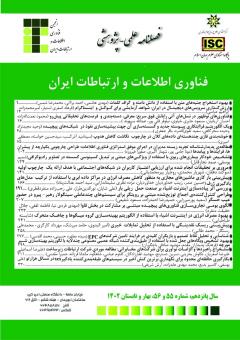شناسایی و تحلیل نقاط تصمیم و بازیگران کلیدی در فرایند تامین شرکت های EPC
محورهای موضوعی : فناوری اطلاعات و ارتباطات
سیده مطهره حسینی
1
![]() ,
محمد اقدسی
2
,
محمد اقدسی
2
1 - دانشجوی دکتری
2 - عضو هیئت علمی
کلید واژه: فرایندکاوي, تحلید تصمیم, مدیریت فرایندهاي کس وکار, تجزیه و تحلید شبكه اجتماعي, فرایند تامین, شرکتهاي EPC,
چکیده مقاله :
تصممیمات درسمت و بهموقع تاثیر بسمزایي در عملكرد و دسمتیابي شمرکت به اهداو ود دارد بهبیانيدیگر مدیریت فرایندهاي کس وکار، به اتخاذ و اجراي تصممیمات منطقي وابسته اسمت با افزای یكپارچه سمایي سمیسمتمهاي اطلاعاتي در سمایمانها و با اسمتفاده ای ابزارهایي مانند فرایندکاوي، بسممتري جهت اسممتفاده ای رویكردهاي جدید تحلید داده و تحلید بهتر تصمممیمات فراهم شمده و مدیران ميتوانند در تصمیم گیريها به صورت چالاک عمد نمایند انتخاب تامینکننده در فرایند رید در پروژههاي پیچیده، یكي ای تصمیمات اثرگذار در کیفیت، هزینه و عملكرد پروژه اسممت در این مقاله با دیدگاه فرایندي، نقات تصمممیم در فرایند رید در یو پروژه سما ت پیچیده در یو شمرکت EPC کشم و با تحلید شمبكه اجتماعي باییگران کلیدي در اجراي فرایند شمناسمایي و بررسمي شده اسمت نتای حاصمد ای این تحقی به بررسمي جایگاه نقات تصممیم در جریان فرایندي، عملكرد نقات تصممیم و نیز شمناسمایي افراد کلیدي در اتخاذ تصمیمات منجر شده که ميتواند در بهبود عملكرد آتي شرکت مورد استفاده قرار گیرد
Correct and timely decisions have a significant impact on the performance and achievement of the company's goals. In other words, business process management depends on making and implementing rational decisions. By increasing the integration of information systems in organizations and using tools such as process mining, a platform is provided for the use of data analysis approaches and better analysis of decisions, and managers can act in agile decision making. Selecting a supplier in the process of purchasing in complex projects is one of the basic and key decisions that affect the quality, cost and performance of the project. In this article, with a process perspective, the decision points in the purchasing process in a complex construction project in an EPC company have been discovered and the key players in the implementation of the process have been identified and analyzed through social network analysis. The results of this research have led to the investigation of decision points in the process, the performance of decision points and the identification of key people in decision making, which can be used to improve the company's future performance.


